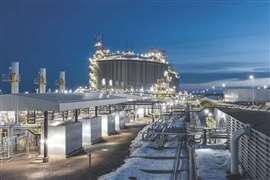IHI and GE Vernova open ammonia combustion test facility in Japan
June 23, 2025
New site aims to accelerate development of carbon-free gas turbines for power generation
 Overview of large-scale combustion test facility built in IHI’s Aioi Works. (Image: IHI)
Overview of large-scale combustion test facility built in IHI’s Aioi Works. (Image: IHI)
IHI Corp. and GE Vernova have completed construction of a large-scale combustion test (LCT) facility in Hyogo, Japan, as part of their joint effort to develop carbon-free gas turbine technology using ammonia as a primary fuel source. The announcement marks a key milestone in a multiyear collaboration to commercialize ammonia-fueled power generation systems by the end of the decade.
Located at IHI’s Aioi Works facility, the new test site is specifically designed to support full-scale combustion testing under GE Vernova’s F-class gas turbine operating conditions. This includes the capability to replicate real-world pressures, temperatures, and flow rates for both air and fuel—key parameters for validating next-generation combustor designs.
The facility will serve as a hub for joint development under a 2024 technology roadmap signed by the two companies. The agreement targets the deployment of a 100% ammonia-capable combustion system by 2030. Testing at the new site is expected to begin in summer 2025, using full-scale prototype combustors.
“This milestone marks a significant step forward in the joint technology roadmap aiming to lead to a 100% ammonia-capable combustion system by 2030,” said Kensuke Yamamoto, executive officer at IHI and general manager of its Ammonia Value Chain Project Department. “The LCT will be a crucial hub for IHI’s and GE Vernova’s project and demonstrates our commitment to advancing ammonia as a sustainable energy solution.”
Ammonia, which contains no carbon, has gained increasing attention as a hydrogen-derived fuel with the potential to decarbonize hard-to-abate sectors such as thermal power generation. Unlike hydrogen gas, ammonia is easier to transport and store, and when combusted properly, it can produce energy without emitting carbon dioxide.
IHI has already developed a 2MW-class gas turbine (model IM270) capable of firing 100% ammonia. The company now aims to scale that technology for use in large-frame gas turbines through its collaboration with GE Vernova, leveraging its new test infrastructure.
The partnership also benefits from synergies with GE Vernova’s combustion research activities in the United States. GE’s advanced combustion test facility in Greenville, South Carolina, has played a key role in developing hydrogen-ready gas turbines and will support the ammonia program with data sharing and technical input.
“This announcement signals a shift from initial studies on the ammonia value chain to the practical implementation of technologies and engineering projects,” said Jeffrey Goldmeer, senior director for technology strategy at GE Vernova. “Our goal is to decarbonize power generation by using ammonia as a fuel. This marks a new phase of collaboration between GE Vernova and IHI—developing decarbonization pathways that safeguard existing power generation investments.”
The LCT initiative builds on broader global interest in ammonia as an alternative fuel. Currently used in fertilizer production and chemical manufacturing, ammonia can also act as a hydrogen carrier. Its potential for direct use in gas turbines is attracting investment from utilities, turbine OEMs, and energy ministries across Asia and Europe, particularly in countries with limited domestic energy resources.
Japan has emerged as a leader in ammonia combustion research, driven by national decarbonization goals and energy security concerns. The Ministry of Economy, Trade and Industry (METI) has promoted ammonia co-firing and full firing in thermal power plants as part of its Green Transformation (GX) strategy. IHI has been a core contributor to these national efforts, conducting ammonia co-firing demonstrations at coal and gas power plants over the past several years.
The new LCT facility supports a broader push to shift from laboratory-scale testing to operationally relevant validation. It is expected to accelerate commercialization of ammonia-fueled turbines that could be deployed globally, especially in markets seeking drop-in solutions for existing gas infrastructure.
The collaboration also seeks to align ammonia turbine development with safety, emissions, and operability standards, addressing some of the key challenges associated with ammonia combustion, such as nitrogen oxide (NOx) formation and flame stability.
GE Vernova has committed to developing a suite of technologies to enable lower-carbon and carbon-free fuels in gas turbines, ranging from hydrogen blends to full ammonia combustion. The company’s F-class turbines are widely deployed around the world and represent a prime candidate for retrofitting with new combustor technologies if ammonia solutions prove technically and commercially viable.
“This project aligns with our broader strategy to decarbonize power while leveraging existing assets and infrastructure,” Goldmeer added. “Ammonia combustion technology could provide a critical tool in balancing energy reliability and climate goals.”
IHI and GE Vernova say the LCT facility will serve as a platform not only for technical development but also for industry collaboration, potentially involving other stakeholders across the ammonia supply chain—from production and logistics to safety systems and regulatory support.
If successful, the companies could bring to market a 100% ammonia-fueled gas turbine system by 2030, offering power producers a new tool in the transition to net-zero emissions without abandoning proven gas turbine technology.
MAGAZINE
NEWSLETTER

CONNECT WITH THE TEAM









